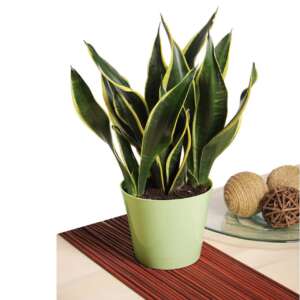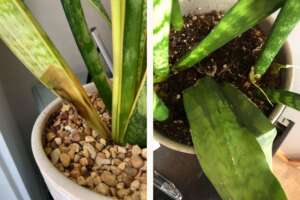Table of Contents
 Snake plants can be seen in many gardens, houses, and parks these days. People preferably plant snake plants because they need very minimal maintenance. These plants are very cheap as well compared to other plants these days.Â
Snake plants can be seen in many gardens, houses, and parks these days. People preferably plant snake plants because they need very minimal maintenance. These plants are very cheap as well compared to other plants these days.Â
As many people have already grown snake plants, others ask for maintenance tips. People place them in bedrooms, kitchens, and bathrooms to add a natural aesthetic to their living areas. However, many people ask questions regarding the watering procedure for snake plants. How much water do snake plants need?
What are the best strategies to keep the snake plant in good health? If you are looking for answers to such questions, you are on the right page.Â
Continue reading to find out the best ways to water your snake plant to keep it in the best health conditions.Â
What are snake plants?
While many people are seeking answers to watering the snake plants, others are not familiar with the nature of plants. Snake plants are mostly coming from the south and west parts of Africa. Due to favorable climate conditions, you can also find snake plants in tropical areas such as Florida.
The scientific notion for the snake plant is Sansevieria trifasciata. Many people also call the plant a mother-in-law’s tongue ironically. Due to the sharp end nodes and pointed leaves, the plants are infamous for this name.Â
Snake plants  have different shapes in different variants. However, the most popular ones include dark green sharp leaves with tiger stripes on them. The color pattern of tiger stripes is slightly lighter than the whole leaf, and this double-shaded feature adds more distinctiveness and beauty to the plant.Â
How much water do snake plants need at best?

The process to water snake plants is not as simple if you want to extract the best length, color, and cylindrical leaves from the plant. At the same time, if the watering is not right, the plant may also look dull. Edgy nodes and sharp ends of leaves may also start turning brown. All you need to do is follow the easy step-by-step guide beneath for the best health of your snake plant.
Before deciding on the watering, some parameters can help better to determine the nature of watering your snake plant requires. Consider these environmental conditions first.Â
You may also like:All About Snail Diet: What Does Garden Snails Eat?
2.1. Checkout the soil condition
You can double-check the soil conditions before watering your plant. Do not water the plant if you feel that soil is still wet. Watering can cause diseases. However, the best way to find out if watering is required is by touching the soil surface. If you feel that the upper layer is dry, you can water the plant. One way is to dig a little in one to two inches in the soil. If soil to this level is dry, water the snake plant.Â
2.2. Keep season and temperature in mind
In the spring season, water requires more energy. As the plant reacts according to dormant periods during spring, it is the peak time when a plant grows the most. So in spring, plants require more water naturally.Â
With time as summer and autumn come, the plant slows down that growth, and gradually less energy is required to the plant. Consequently, you still need to water the plant but not as much as in the spring season. In fall, sometimes water is unnecessary to the snake plant. You need to be very vigilant in spring and fall particularly. If you over-water the plant in the fall, it can cause damage to the plant’s root.
 Keep in mind that in spring or another season, sometimes snakes plant flowers. You can cut the stems of flowers if you cannot take extra care of the plant. Flowers require more energy to bloom, and they consume more water, hence you have to water more often when the snake plant is flowering.Â
You may also like:
Ideally, the snake plant survives best if placed in a temperature setting of 12-30 degree centigrades. In winters, these plants sometimes the temperature drop to 10 degrees. Then the plant can start yellowing. You can consider changing the place of plants in winters if possible. If the temperature goes very hot, it can also damage the plant. An ideal situation can be to place the plant in moderate conditions.Â
2.3. Look for location and humidity level of snake plant
The snake plant is robust and deterred. Usually, it survives under certain conditions. However, if the humidity levels increase so much and the air is too dry, snake plants may suffer. Similarly, a lot of humidity in the air can also cause the plant to catch mildew on the surface.Â
Indoor snake plants are more prone to humidity changes as centralized air conditioning(hot and cold) is very common indoors. The shift in humidity indoors can damage the plant. Keep in mind that if the air is too humid, water is less. If the humidity is too less, water more.
Keep in mind that with time your snake plant will turn tall. It will also take a little more space. Make sure that you are not placing the snake plant in a light-deprived area. It can damage the plant. Moreover, snake plants do not like direct sunlight. Although the plant can survive in the sun, the water will evaporate more quickly. Consequently, you have to water the snake plant more often.
It is the best practice to keep the plant in the window facing east and west. You know the all-time sunny and shady areas of your place. Keep snake plants in a moderate environment to enjoy their full bloom.Â
2.4. Do not overwater snake plants

Believe it or not, but overwatering snake plants is one of the root causes of many plant diseases. However, you must maintain the water level frequently. Be careful, especially in winters. In winters, plants do not quickly dry out so you might overwater without looking at the soil of the plant. Overwatering can rot the plant. Initially, the plant will start turning yellow, pale, and then it will turn the sharp ends of leaves into brown.Â
2.5. Maintain the frequency of watering.
The best practice to keep the snake plant at its best is by maintaining the frequency of watering.Â
- Overwatering snake plants can cause damage to their roots. The roots will rot if the excess water reaches them.
- Less watering will hinder plant growth. Water provides energy to plants to grow at their best. You might notice less growth in snake plants if you water very little.Â
Check out the water conditions by tapping the soil and you will get to know if the plant needs water or not.Â
Conclusion
Snake plants are desert plants. Although they do survive under severe conditions, keeping them in a challenging environment all the time can restrict their growth. Very dry air can turn the plant yellow. Similarly, excessive humid air can let the mold set on the plant leading to plant diseases.
It is best practice to keep the plant under moderate conditions. Check out the 1-2 inches of soil surface. If it is dry then water the plant. If the surface is wet, do not water unless it dries out. In winters, snake plant requires less water, while in spring it requires more water as in that time the plant grows.

